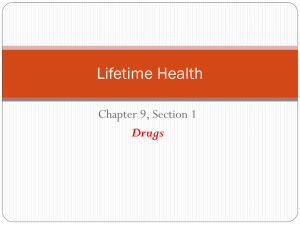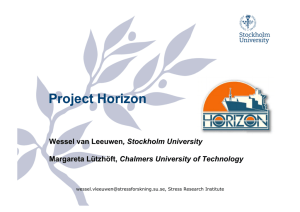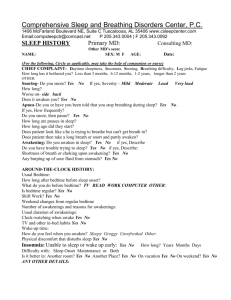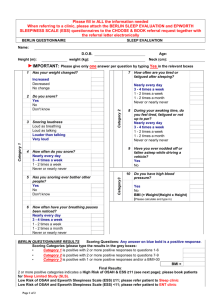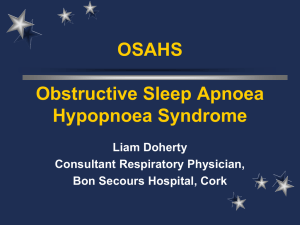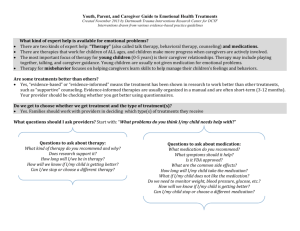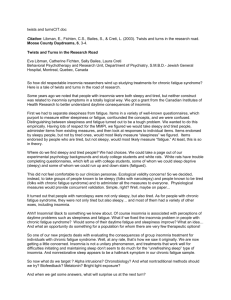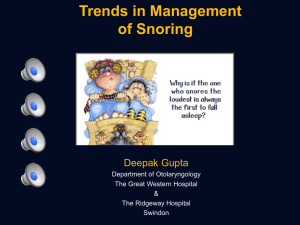Published Version (MS Word 104kB)
advertisement
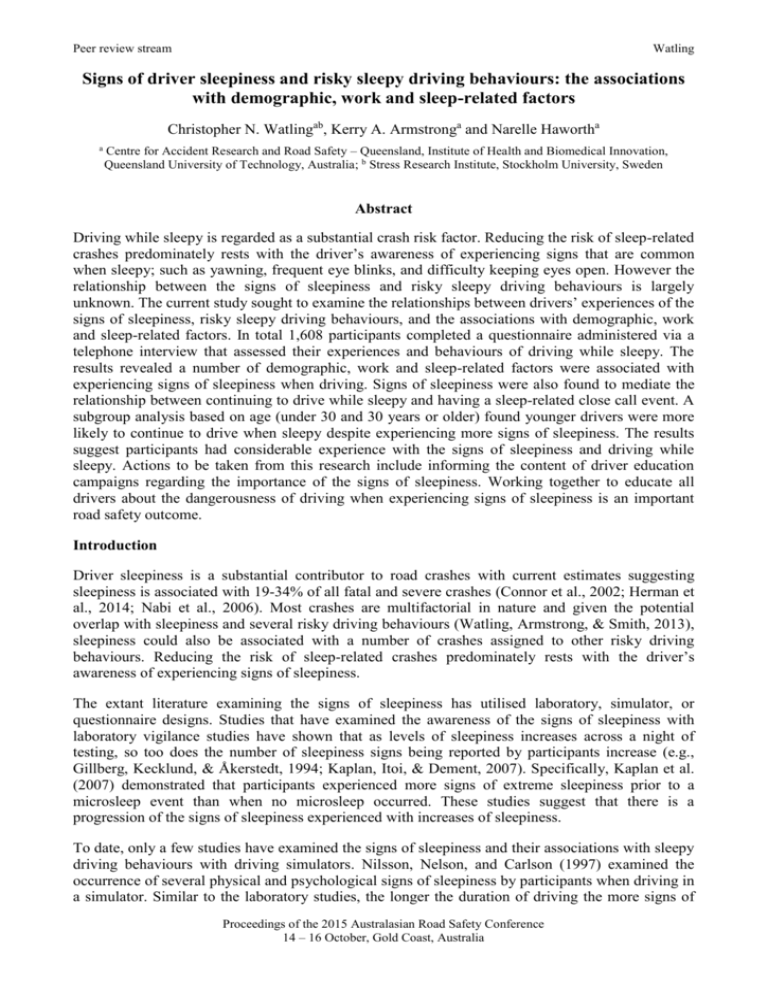
Peer review stream Watling Signs of driver sleepiness and risky sleepy driving behaviours: the associations with demographic, work and sleep-related factors Christopher N. Watlingab, Kerry A. Armstronga and Narelle Hawortha a Centre for Accident Research and Road Safety – Queensland, Institute of Health and Biomedical Innovation, Queensland University of Technology, Australia; b Stress Research Institute, Stockholm University, Sweden Abstract Driving while sleepy is regarded as a substantial crash risk factor. Reducing the risk of sleep-related crashes predominately rests with the driver’s awareness of experiencing signs that are common when sleepy; such as yawning, frequent eye blinks, and difficulty keeping eyes open. However the relationship between the signs of sleepiness and risky sleepy driving behaviours is largely unknown. The current study sought to examine the relationships between drivers’ experiences of the signs of sleepiness, risky sleepy driving behaviours, and the associations with demographic, work and sleep-related factors. In total 1,608 participants completed a questionnaire administered via a telephone interview that assessed their experiences and behaviours of driving while sleepy. The results revealed a number of demographic, work and sleep-related factors were associated with experiencing signs of sleepiness when driving. Signs of sleepiness were also found to mediate the relationship between continuing to drive while sleepy and having a sleep-related close call event. A subgroup analysis based on age (under 30 and 30 years or older) found younger drivers were more likely to continue to drive when sleepy despite experiencing more signs of sleepiness. The results suggest participants had considerable experience with the signs of sleepiness and driving while sleepy. Actions to be taken from this research include informing the content of driver education campaigns regarding the importance of the signs of sleepiness. Working together to educate all drivers about the dangerousness of driving when experiencing signs of sleepiness is an important road safety outcome. Introduction Driver sleepiness is a substantial contributor to road crashes with current estimates suggesting sleepiness is associated with 19-34% of all fatal and severe crashes (Connor et al., 2002; Herman et al., 2014; Nabi et al., 2006). Most crashes are multifactorial in nature and given the potential overlap with sleepiness and several risky driving behaviours (Watling, Armstrong, & Smith, 2013), sleepiness could also be associated with a number of crashes assigned to other risky driving behaviours. Reducing the risk of sleep-related crashes predominately rests with the driver’s awareness of experiencing signs of sleepiness. The extant literature examining the signs of sleepiness has utilised laboratory, simulator, or questionnaire designs. Studies that have examined the awareness of the signs of sleepiness with laboratory vigilance studies have shown that as levels of sleepiness increases across a night of testing, so too does the number of sleepiness signs being reported by participants increase (e.g., Gillberg, Kecklund, & Åkerstedt, 1994; Kaplan, Itoi, & Dement, 2007). Specifically, Kaplan et al. (2007) demonstrated that participants experienced more signs of extreme sleepiness prior to a microsleep event than when no microsleep occurred. These studies suggest that there is a progression of the signs of sleepiness experienced with increases of sleepiness. To date, only a few studies have examined the signs of sleepiness and their associations with sleepy driving behaviours with driving simulators. Nilsson, Nelson, and Carlson (1997) examined the occurrence of several physical and psychological signs of sleepiness by participants when driving in a simulator. Similar to the laboratory studies, the longer the duration of driving the more signs of Proceedings of the 2015 Australasian Road Safety Conference 14 – 16 October, Gold Coast, Australia Peer review stream Watling sleepiness were reported by participants. Recently, a driving simulator study by Howard et al. (2014) revealed that participants reported experiencing the signs of sleepiness more frequently as physiological and subjective sleepiness increased and this was also associated with greater levels of impaired driving performance. Signs of sleepiness that were specifically associated with severely impaired simulated driving performance were related to visual disturbances (e.g., struggling to keep your eyes open) and overt signs of sleepiness impaired driving performance (e.g., difficulty maintain correct speed). Considered together, the studies presented suggest that as physiological and subjective indices of sleepiness increase so too does the number of signs of sleepiness experienced and this increase also corresponds to impaired simulated driving performance. Most importantly, these studies demonstrate that drivers are capable of perceiving the signs of sleepiness. An aspect of drivers’ experiences with the signs of sleepiness that has not been thoroughly examined is the association between individual factors and experiencing signs of sleepiness. Nordbakke and Sagberg (2007) examined the association between specific signs of sleepiness and demographic factors (sex and younger and older drivers) as well as falling asleep versus being close to falling asleep. Younger drivers were more likely to report experiencing early signs of sleepiness (e.g., yawning, more frequent eye blinks) and some extreme signs of sleepiness (i.e., difficulty concentrating on driving, dreamlike state of consciousness) than older drivers. While the findings from this study are informative, a number of other individual factors (apart from demographic factors) have been previously found to be associated with sleepy driving behaviours and thus, could be associated with experiencing signs of sleepiness. Individual factors that have been associated with sleepy driving include demographic factors such as education (Sagberg, 1999) and the number of hours driven per week/yearly mileage (Radun, Radun, Wahde, Watling, & Kecklund, 2015). Being a shift worker (Di Milia, 2006) and a professional driver (Carter, Ulfberg, Nyström, & Edling, 2003) are factors that expose the individual to greater levels of sleepiness and hence more opportunities to experience the signs of sleepiness. Sleep-related factors could also be associated with experiencing more signs of sleepiness, including experiencing frequent daytime sleepiness or poor sleep quality (Bartlett, Marshall, Williams, & Grunstein, 2008). Last, drivers that have previous experience with risky sleepy driving behaviours, such as driving while sleepy and having a sleep-related close call, are potentially more likely to have experienced signs of sleepiness. Reducing the risk of sleep-related crashes predominately rests with the driver’s awareness of experiencing signs of sleepiness. As such, understanding the associations between individual factors, risky sleepy driving behaviours, and experiences of the signs of sleepiness is an important undertaking for road safety. Therefore, the first aim of the study was to examine the association between demographic, work and sleep-related variables with the signs of sleepiness. The second aim was to examine the relationships between signs of driver sleepiness, continuing to drive when sleepy and sleep-related close calls. The third aim sought to determine differences between younger (17-29 years of age) and older (> 30 years of age) individuals as well as between females and males regarding risky sleepy driving behaviours and the main study variables. Method Participants Participants were required to be aged 17 years or older, to hold a current drivers licence and to drive a vehicle (work or private) more than one hour per week. These inclusion criteria were chosen to ensure that participants had sufficient on-road driving experience. Altogether, 1,608 participants took part in the study. A representative sample of drivers from New South Wales and the Australian Capital Territory was obtained based on the stratification of vehicles registered located in the statistical divisions. The Proceedings of the 2015 Australasian Road Safety Conference 14 – 16 October, Gold Coast, Australia Peer review stream Watling statistical divisions are a general purpose spatial unit and are the largest and most stable spatial unit within each state/territory of Australia (Australian Bureau of Statistics, 2011). The sample was also stratified based on age, with half of the participants below the age of 30 years, as well as sex, with equal numbers of males and females to ensure the results were not biased from under or oversampling of demographic variables. Measures The first section of the questionnaire recorded demographic information such as age, sex, and education level. Following this, participants were asked about any previous sleepy driving experiences in the last five years. The relevant peer reviewed literature concerned with signs of driver sleepiness was reviewed and eight signs of driver sleepiness were utilised. They included physical and psychological signs (e.g., yawning, changing position frequently frequent eye blinks, difficulty keeping eyes open, and a dreamlike state of consciousness) and signs of sleepiness associated with vehicle control (e.g., difficulty concentrating on driving, slower reaction to traffic events, and increased variation in speed). The remaining items asked if participants had in the last five years, continued to drive when sleepy and if they have had a sleep-related close call. Participants responded to these questions ‘yes’ or ‘no’. Participants were then asked questions relating to the number of hours driven per week, whether they were a professional driver, or a shift worker. Finally, questions were included that concerned participants sleep health-related variables such as if they had difficulty getting to sleep (yes or no), the number of hours slept per night, quality of their normal sleep (4-point Likert scale: 1-poor to 4-excellent), and if they experienced frequent daytime sleepiness (yes or no). Procedure The research protocol was approved by the University Human Research Ethics Committee. An independent data collection organisation was commissioned to collect the data. The study data was collected via a telephone surveying methodology, using a Computer Assisted Telephone Interview system. Interviews that took place during the weekdays were conducted between 16:30 to 20:30 and on the weekends were conducted between 09:00 and 17:00. Participants were sourced from the Association of Market and Social Research Organisations Random Digit Dialling system. Participants were first read an introductory statement that explained the purpose of the study and that responses were completely confidential. Informed consent via a verbal confirmation from the participant was obtained for all participants. In total, a response rate of 17.31% was achieved. Statistical Analyses To examine the first aim of the study, the association between individual factors and experiences of signs of driver sleepiness, a hierarchical linear regression was performed. The outcome variable was the summation of the participants’ experiences of specific signs of sleepiness with the predictor variables being the demographic, work and sleep-related variables. To examine the second aim regarding the relationships between signs of driver sleepiness, continuing to drive when sleepy and sleep-related close calls, a mediation analysis was performed. The relationships between continuing to drive when sleepy and sleep-related close call with signs of sleepiness as the mediator variable were tested with the procedure designed by Hayes (2013) with the significance of the indirect pathways assessed with bootstrapping. The third aim utilised Mann-Whitney U and Chi-squared analyses to determine differences between younger (17-29 years of age) and older (> 30 years of age) participants as well as between females and males for the main study variables. Proceedings of the 2015 Australasian Road Safety Conference 14 – 16 October, Gold Coast, Australia Peer review stream Watling Results Signs of Sleepiness Descriptives Table 1 displays the proportion of participants that had previously experienced signs of sleepiness and the descriptive statistics (means and standard deviations or percentage) for the study variables. It can be seen that over half of the participants had previously experienced yawning, changing position frequently, frequent eye blinks and difficulty concentration on driving in the past. Yawning, an early sign of sleepiness was the most reported experience; with dreamlike state of consciousness the least experienced sign of sleepiness. On average, participants reported having previously experienced four of the eight signs of driving sleepiness, with a moderate amount of variability. Approximately two-thirds of participants had previously continued to drive when sleepy in the last five years with 15.79% of participants reported previously having a sleep-related close call in previous five-year period. Table 1. Descriptive statistics of the main study variables Study variables Descriptive Range Yawning 83.34% Change position frequently 58.73% Frequent eye blinks 51.40% Difficulty concentrating on driving 50.59% Slower reaction to traffic events 39.78% Increased variation in speed 38.60% Difficulty keeping eyes open 35.11% Dreamlike state of consciousness 24.11% Total signs of sleepinessa 4.12 ± 2.10 1-8 Hours driving per week (>8hrs) 35.74% Age 37.66 ± 17.65 17-90 Sex (male) 50.03% Education level (tertiary level) 36.36% Professional driver (yes) 13.66% Shift worker (yes) 12.49% Continued driving while sleepy (yes) 65.88% Ever had a sleep-related close call (yes) 15.79% Difficulty getting to sleep (yes) 37.04% Hours of sleep per night 7.29 ± 1.17 4-10 Quality of normal sleep 2.56 ± 0.82 1-4 Frequent daytime sleepiness (yes) 16.22% a Total signs of sleepiness variable was the summation of the eight specific signs of sleepiness Hierarchical multiple regression was performed to examine which of the demographic, work, and sleep-related variables were associated with the total signs of sleepiness outcome variable and can been seen in Table 2 (over page). At the first step, hours driving per week was entered into the model, which significantly predicted signs of sleepiness and accounted for 1% of the variance. At the second step the demographic variables were included into the model, which significantly predicted signs of sleepiness and accounted for 5% of the variance, an increase of 4%. Hours driving per week, age, and education were all significantly associated with signs of sleepiness. The last step saw the remaining work and sleep-related variables entered into the model, which significantly predicted signs of sleepiness and accounted for 31% of the variance, an increase of 26%. Of the variables that were entered at the third step, being a professional driver, continue to drive when sleepy, sleep-related close call, hours of sleep per night, quality of sleep, and experiencing frequent daytime sleepiness were significantly associated with the outcome variable sign of sleepiness. The variables with the largest associations with the signs of sleepiness outcome variable were continuing to drive when sleepy, followed by sleep-related close call, and hours of sleep per night. Proceedings of the 2015 Australasian Road Safety Conference 14 – 16 October, Gold Coast, Australia Peer review stream Watling Table 2. Hierarchical multiple regression analysis of total signs of sleepiness and the demographic, work and sleep-related variables Study variable b SE b β Step 1 Hours driving per week (>8hrs) -0.25* .11 -.06 Constant -3.73** .07 Adjusted R2 = .01; F(1, 1595) = 5.01* Step 2 Hours driving per week (>8hrs) -0.28* .11 -.06 Age -0.02** .01 -.19 Sex (male) -0.09 .10 -.02 Education (tertiary level) -0.58** .11 -.13 Constant -4.42** .14 Adjusted R2 = .05; F(4, 1592) = 22.47**; R2 change = .04; Fchange(3, 1592) = 28.20** Step 3 Hours driving per week (>8hrs) -0.08 .10 -.02 Age -0.01** .01 -.09 Sex (male) -0.31** .09 -.07 Education (tertiary level) -0.39** .09 -.09 Professional driver (yes) -0.22* .10 -.05 Shift worker (yes) -0.09 .14 -.01 Continue to drive when sleepy (yes) -1.66** .10 -.37 Sleep-related close call (yes) -1.36** .12 -.24 Difficulty getting to sleep (yes) -0.01 .11 -.01 Hours of sleep per night -0.17** .04 -.09 Quality of normal sleep -0.13* .07 -.05 Frequent daytime sleepiness (yes) -0.28** .13 -.05 Constant -3.75** .28 Adjusted R2 = .31; F(12, 1584) = 61.22**; R2 change = .26; Fchange(8, 1584) = 77.13** rab.c ra(bc) -.06 -.06 -.06 -.19 -.02 -.13 -.06 -.19 -.02 -.13 -.02 -.10 -.09 -.11 -.06 -.02 -.39 -.27 -.01 -.10 -.05 -.06 -.02 -.09 -.07 -.09 -.05 -.01 -.35 -.23 -.01 -.09 -.04 -.05 ** p < .01, *p < .05 Signs of Sleepiness and Risky Sleepy Driving Behaviours Continuing to drive when sleepy was significantly associated with sleep-related close call (B = 1.24, p < .001). Similarly, continuing to drive when sleepy was significantly associated with signs of sleepiness (B = 2.07, p < .001). Signs of sleepiness was significantly associated with sleep-related close calls (B = 0.48, p < .001). A significant association was found between signs of sleepiness and sleep-related close calls when controlling for the association of continuing to drive when sleepy, B = 0.45, p < .001. The relationship between continuing to drive when sleepy and sleep-related close calls decreased to B = 0.49, p = .014. The significance of the indirect pathway was evaluated with a bootstrapping procedure (Hayes, 2013). The bootstrapping range (2000 bootstrap resamples) with 95% bias corrected for the signs of sleepiness variable was, 0.74 to 1.11. Overall, the mediator model (see Figure 1) accounted for 18.53% of the variance (Nagelkerke R2). a = 2.07** Total signs of sleepiness b = 0.45** c = 1.24** Continue to drive when sleepy Sleep-related close call c’ = 0.49* Figure 1. Mediation model of Continue to drive when sleepy with sleep-related close call as mediated by signs of sleepiness – unstandardised coefficients shown. **p < .01, *p < .05 Proceedings of the 2015 Australasian Road Safety Conference 14 – 16 October, Gold Coast, Australia Peer review stream Watling Subgroup Analyses A number of significant differences were found between the younger age group (17-29 years of age) and the older group (> 30 years of age) and can be seen in Table 3. The younger group were more likely to report continuing to drive when sleepy as well as experience more of the signs of sleepiness. Males were more likely to report having more sleep-related close calls and to continue to drive when sleepy than females. Table 3. Age and sex comparisons for the sleepy driving variables Age Statistical Sex comparison 17-29 > 30 Female Male 14.63% 16.93% χ2(1) = 1.61 11.94% 19.63% 74.25% 57.60% χ2(1) = 49.60** 39.44% 62.31% M = 3.99 M = 4.04 M = 3.85 U = 294628.50** M = 4.05 Note: **p < .01, *p < .05; χ2 denotes chi-squared statistic; U denotes the Mann-Whitney statistic. Variable Sleep-related close calls Continue to drive when sleepy Total signs of sleepiness Statistical comparison χ2(1) = 17.88** χ2(1) = 9.09** U = 318059.00 Discussion The current study sought to examine the relationships between drivers’ experiences of the signs of sleepiness, risky sleepy driving behaviours, and the associations with demographic, work and sleeprelated factors. The results reveal that a number of demographic, work and sleep-related factors were associated with experiencing signs of sleepiness while driving. Moreover, the signs of sleepiness were also associated with certain sleepy driving behaviours. The study results suggest that participants had considerable experience with many signs of sleepiness. It was found that over half of the participants reported having previously experienced four of the eight signs of sleepiness. These included: Yawning, changing position frequently, frequent eye blink, and difficulty concentrating on driving. These particular signs of sleepiness could be described as early signs and experienced during initial development of sleepiness. It is notable that the earlier signs of sleepiness (e.g., yawning, changing position frequently) were reported as having been experienced the most, with the more advanced signs of sleepiness (e.g., difficulty keeping eyes open, dreamlike state of consciousness) experienced less – this pattern of experiencing the signs of sleepiness is consistent with previous research (Kaplan et al., 2007; Nordbakke & Sagberg, 2007). Nonetheless, it is concerning that approximately a third of participants had previously experienced two of the more advanced signs of sleepiness such as keeping eyes open and dreamlike state of consciousness. Simulator studies demonstrate that “struggling to keep your eyes open” had the strongest relationship with impaired driving performance (Howard et al., 2014). Moreover, difficulties keeping eyes open could be considered an eight or a nine on the widely used Karolinska Sleepiness Scale (KSS: Åkerstedt & Gillberg, 1990). Biomathematical modelling with retrospective crash data has determined that scoring an 8 or 9 on the KSS is associated with a 7 to 9 times increase in the likelihood of crashing when driving a motor vehicle (Åkerstedt, Connor, Gray, & Kecklund, 2008). The first aim of the study was to examine the association between demographic, work-, and sleeprelated variables with the signs of sleepiness. A number of demographic, work and sleep-related factors were associated with experiencing signs of sleepiness while driving with the hierarchical regression analysis. At the final step of the regression the demographic and work-related factors of age (being younger), sex (being female), having a tertiary level of education, and being a professional driver were associated with having experienced more of the signs of sleepiness. Previous research demonstrates that younger drivers (Nordbakke & Sagberg, 2007) and professional drivers (Carter et al., 2003) frequently drive while sleepy and this would likely predispose them to experiencing more of the signs of sleepiness. It was somewhat unexpected that females were more likely to be associated with experiencing signs of sleepiness than males as previous research has Proceedings of the 2015 Australasian Road Safety Conference 14 – 16 October, Gold Coast, Australia Peer review stream Watling shown that males, compared to females, are more likely to report driving when sleepy (Radun et al., 2015). Nordbakke and Sagberg (2007) determined that signs of sleepiness such as “feeling cold” and “increased variations in speed” were experienced more by female drivers, but overall, few differences were evident between males and females. The association between having a tertiary education and experiencing more signs of sleepiness is a novel finding. Previous research has demonstrated an association between higher education levels and greater likelihood of being involved in a sleep-related crash (Sagberg, 1999) and individuals with higher education levels are more likely to report shorter sleeping durations (Lauderdale et al., 2006) and thus might have a greater sleep debt which could increase general levels of sleepiness. Perhaps the most straightforward findings are the sleep-related factors associated with signs of sleepiness. The variables of hours of sleep per night (fewer hours), quality of normal sleep (poor quality), and experiencing frequent daytime sleepiness were all related to experiencing more signs of sleepiness. These findings are consistent with previous research (Connor et al., 2002; Radun et al., 2015) and further support the importance of sleep health as a protective factor for negating sleepiness while driving. It must be noted that while the magnitude of the associations between the sleep-related factors and experiencing signs of sleepiness were small, they were still significant after controlling for a number of demographic factors and sleepy driving behaviours. Two-thirds of the participants reported having previously continued driving while sleepy in the past. This finding is consistent with previous research conducted on representative samples in Norway (Nordbakke & Sagberg, 2007) and Canada (Vanlaar, Simpson, Mayhew, & Robertson, 2008) that documented between 59 and 73 percent of drivers report that they would continue to drive despite being aware of their sleepiness. The percentage of drivers reported having a previous close call in the current study was 16%. This percentage is consistent with a large North American study that found 18% of its 35,217 drivers reported having had a close call previously (Powell et al., 2007). These two sleep-related driving variables had the strongest associations with experiencing more signs of sleepiness. These relationships were further examined with a mediation analysis. The second aim was to examine the relationships between signs of driver sleepiness, continuing to drive when sleepy and sleep-related close calls. The current data supported a mediation model of these variables. Specifically, drivers who had previously continued driving while sleepy were more likely to also report having a sleep-related close call, with this relationship partially mediated by having experienced more signs of sleepiness. Increasing experiences of the numbers of signs of sleepiness are associated with microsleeps (Kaplan et al., 2007) and with greater levels of impaired simulated driving (Howard et al., 2014). This mediation model emphasises the importance a driver should take with their experiences of the signs of sleepiness. Last, the dangerousness of having a close call has been demonstrated by Powell et al. (2007) with drivers who have previously had one close call being 1.13 times more likely to have a sleep-related crash. In the absence of a reliable and more importantly, a valid technological device that can measure a driver’s level of sleepiness, drivers are reliant on self-awareness of experiencing the signs of sleepiness as a guide to their level of impairment. A growing body of literature is demonstrating that drivers’ can perceive increasing levels of sleepiness (Reyner & Horne, 1998; Watling, Smith, & Horswill, 2015; Williamson, Friswell, Olivier, & Grzebieta, 2014). Yet, with such large proportions of drivers choosing to drive while sleepy or to continue to drive while sleepy, it seems likely that several factors could affect drivers’ decision making. For instance, motivations as well as risk perceptions are important factors associated with continuing to drive while sleepy (Watling, Armstrong, Obst, & Smith, 2014). Moreover, some drivers might also overestimate how effectual fighting sleepiness actually can be. This sentiment is supported by research demonstrating that the accuracy of predicting the likelihood of falling asleep is poor when experiencing an advanced level of sleepiness, such as when sleep onset is being actively fought (Kaplan et al., 2007). However, at Proceedings of the 2015 Australasian Road Safety Conference 14 – 16 October, Gold Coast, Australia Peer review stream Watling such levels of sleepiness it has been suggested that an individual is well past the point of impairment from sleepiness (Kribbs & Dinges, 1994) and thus, taking prompt action and employing the more effective countermeasures (i.e., naps, coffee) is of critical importance for road safety. The third aim sought to determine differences between younger (17-29 years of age) and older (> 30 years of age) individuals as well as between females and males. This subgroup analysis of younger and older drivers, found younger drivers were more likely to continue to drive when sleepy, despite experiencing more signs of sleepiness. A simulated driving study performed by (Sagberg, Jackson, Krüger, Muzet, & Williams, 2004) also revealed that younger drivers reported more signs of sleepiness than older drivers. This finding is somewhat counterintuitive as older drivers have more accumulated experiences with sleepy driving than younger drivers. Although, it could be that younger persons feel the signs of sleepiness more strongly; previous research suggests that younger drivers display higher levels of physiological sleepiness than older drivers do (Lowden, Anund, Kecklund, Peters, & Åkerstedt, 2009). The subgroup analysis also found females were significantly less likely than males to report having a sleep-related close call as well as to continue driving while sleepy; yet, surprisingly no differences between females and males with the total signs of sleepiness variable were found. Thus, it is likely that other factors such as sensation seeking, impulsivity, and risk taking could have contributed to males performing these risky sleepy driving behaviours more than females. Alternatively, while no differences were found between males and females and their previous experiences with the signs of sleepiness, it could be that females appreciate the dangerousness of the signs of sleepiness to a greater extent than males and as a consequence, perform less risky sleepy driving behaviours than males when they do experience the signs of sleepiness. Moving forward together, driver informational resources, educational campaigns as well as police and community discussion groups could seek to educate drivers about the importance of first, being more cognizant of experiences of the signs of sleepiness when driving, and second, being more conscientious that experiencing more signs of sleepiness when driving indicates an increasing of ones level of sleepiness. Moreover, sleepiness knows no boundaries, such that sleepiness is not just a road safety issue that is solely localised within rural driving environments, but occurs in urban driving environments as well (e.g., Armstrong, Smith, Steinhardt, & Haworth, 2008). Longitudinal epidemiological evidence demonstrates that sleep health is gradually declining (Bixler, 2009) and messages that highlight the importance of sleep health as a protective factor are still important as the current study has shown that several sleep health factors were related to experiencing signs of sleepiness. It is acknowledged that individual’s sleep health will, from time-to-time be poor, the individual then needs to have a heightened appreciation of the risk of driving while sleepy. There are a number of limitations of the study that need to be considered. The data was collected via self-report. Thus, social desirability and recall bias could have affected the results. Given the retrospective and cross-sectional nature of the study design, causality of the obtained relationships cannot be inferred. Future research could seek to explore the effect of age as younger drivers reported experiencing more signs of sleepiness. Previous research has shown certain individuals report fewer signs of sleepiness when at heightened levels of sleepiness (i.e., Kaplan et al., 2007). The basis of this effect should be explored in a driving setting to determine if it is an awareness level or whether it could be associated with a psychological construct (i.e., personality factors). In conclusion, the current study demonstrated that drivers have substantial experience with the signs of sleepiness. Moreover, a number of demographic, work and sleep-related factors were associated with experiencing signs of sleepiness when driving. In particular, continuing to drive while sleepy and having a sleep related close call had the strongest associations with the signs of sleepiness. Additionally, signs of sleepiness were also found to mediate the relationship between continuing to Proceedings of the 2015 Australasian Road Safety Conference 14 – 16 October, Gold Coast, Australia Peer review stream Watling drive while sleepy and having a sleep-related close call event. Working together to educate all drivers about the dangerousness of driving while sleepy is an important undertaking, which could lead to improvements in road safety outcomes and provide a safer road environment for all drivers. Acknowledgements This research was possible due to a funding grant by the NRMA-ACT Road Safety Trust. This work has been prepared exclusively by the authors and is not endorsed or guaranteed by the Trust. References Åkerstedt, T., Connor, J., Gray, A., & Kecklund, G. (2008). Predicting road crashes from a mathematical model of alertness regulation--The Sleep/Wake Predictor. Accident Analysis & Prevention, 40(4), 1480-1485. Åkerstedt, T., & Gillberg, M. (1990). Subjective and objective sleepiness in the active individual. International Journal of Neuroscience, 52(1-2), 29-37. Armstrong, K. A., Smith, S. S., Steinhardt, D. A., & Haworth, N. L. (2008). Fatigue crashes happen in urban areas too: Characteristics of crashes in low speed urban areas. Paper presented at the Australasian Road Safety Research, Policing and Education Conference, 1012 November 2008, Adelaide, South Australia. Australian Bureau of Statistics. (2011). Australian Standard Geographical Classification. Canberra: Commonwealth Government of Australia. Bartlett, D. J., Marshall, N. S., Williams, A., & Grunstein, R. R. (2008). Sleep health New South Wales: chronic sleep restriction and daytime sleepiness. Internal Medicine Journal, 38(1), 2431. Bixler, E. (2009). Sleep and society: An epidemiological perspective. Sleep Medicine, 10, Supplement 1(0), S3-S6. Carter, N., Ulfberg, J., Nyström, B., & Edling, C. (2003). Sleep debt, sleepiness and accidents among males in the general population and male professional drivers. Accident Analysis & Prevention, 35(4), 613-617. Connor, J., Norton, R., Ameratunga, S., Robinson, E., Civil, I., Dunn, R., . . . Jackson, R. (2002). Driver sleepiness and risk of serious injury to car occupants: population based case control study. British Medical Journal, 324(7346), 1125. Di Milia, L. (2006). Shift work, sleepiness and long distance driving. Transportation Research Part F: Traffic Psychology and Behaviour, 9(4), 278-285. Gillberg, M., Kecklund, G., & Åkerstedt, T. (1994). Relations between performance and subjective ratings of sleepiness during a night awake. Sleep, 17, 236-241. Hayes, A. F. (2013). Introduction to mediation, moderation, and conditional process analysis: A regression-based approach: Guilford Press. Herman, J., Kafoa, B., Wainiqolo, I., Robinson, E., McCaig, E., Connor, J., . . . Ameratunga, S. (2014). Driver sleepiness and risk of motor vehicle crash injuries: A population-based case control study in Fiji (TRIP 12). Injury, 45(3), 586-591. Howard, M. E., Jackson, M. L., Berlowitz, D., O'Donoghue, F., Swann, P., Westlake, J., . . . Pierce, R. J. (2014). Specific sleepiness symptoms are indicators of performance impairment during sleep deprivation. Accident Analysis & Prevention, 62, 1-8. Proceedings of the 2015 Australasian Road Safety Conference 14 – 16 October, Gold Coast, Australia Peer review stream Watling Kaplan, K. A., Itoi, A., & Dement, W. C. (2007). Awareness of sleepiness and ability to predict sleep onset: Can drivers avoid falling asleep at the wheel? Sleep Medicine, 9(1), 71-79. Kribbs, N. B., & Dinges, D. (1994). Vigilance decrement and sleepiness. In R. D. Ogilvie & J. R. Harsh (Eds.), Sleep onset: Normal and abnormal processes. (pp. 113-125): American Psychological Association. Lauderdale, D. S., Knutson, K. L., Yan, L. L., Rathouz, P. J., Hulley, S. B., Sidney, S., & Liu, K. (2006). Objectively Measured Sleep Characteristics among Early-Middle-Aged Adults: The CARDIA Study. American Journal of Epidemiology, 164(1), 5-16. Lowden, A., Anund, A., Kecklund, G., Peters, B., & Åkerstedt, T. (2009). Wakefulness in young and elderly subjects driving at night in a car simulator. Accident Analysis & Prevention, 41(5), 1001-1007. Nabi, H., Guéguen, A., Chiron, M., Lafont, S., Zins, M., & Lagarde, E. (2006). Awareness of driving while sleepy and road traffic accidents: prospective study in GAZEL cohort. British Medical Journal, 333(7558), 75-75. Nilsson, T., Nelson, T. M., & Carlson, D. (1997). Development of fatigue symptoms during simulated driving. Accident Analysis & Prevention, 29, 479-488. Nordbakke, S., & Sagberg, F. (2007). Sleepy at the wheel: Knowledge, symptoms and behaviour among car drivers. Transportation Research Part F: Traffic Psychology and Behaviour, 10(1), 1-10. Powell, N. B., Schechtman, K. B., Riley, R. W., Guilleminault, C., Chiang, R. P., & Weaver, E. M. (2007). Sleepy driver near-misses may predict accident risks. Sleep, 30(3), 331-342. Radun, I., Radun, J. E., Wahde, M., Watling, C. N., & Kecklund, G. (2015). Self-reported circumstances and consequences of driving while sleepy. Transportation Research Part F: Traffic Psychology and Behaviour, 32, 91-100. Reyner, L. A., & Horne, J. A. (1998). Falling asleep whilst driving: Are drivers aware of prior sleepiness? International Journal of Legal Medicine, 111(3), 120-123. Sagberg, F. (1999). Road accidents caused by drivers falling asleep. Accident Analysis & Prevention, 31(6), 639-649. Sagberg, F., Jackson, P., Krüger, H.-P., Muzet, A., & Williams, A. (2004). Fatigue, sleepiness and reduced alertness as risk factors in driving. Project Report, Transport RTD. Vanlaar, W., Simpson, H., Mayhew, D., & Robertson, R. (2008). Fatigued and drowsy driving: A survey of attitudes, opinions and behaviors. Journal of Safety Research, 39, 303-309. Watling, C. N., Armstrong, K. A., Obst, P. L., & Smith, S. S. (2014). Continuing to drive while sleepy: The influence of sleepiness countermeasures, motivation for driving sleepy, and risk perception. Accident Analysis & Prevention, 73, 262-268. Watling, C. N., Armstrong, K. A., & Smith, S. S. (2013). Sleepiness : how a biological drive can influence other risky road user behaviours. Paper presented at the 2013 Australasian College of Road Safety (ACRS) National Conference, Adelaide, Australia. Watling, C. N., Smith, S. S., & Horswill, M. S. (2015). Psychophysiological changes associated with self-regulation of sleepiness and cessation from a hazard perception task. Journal of Psychophysiology, (in press). Williamson, A. M., Friswell, R., Olivier, J., & Grzebieta, R. (2014). Are drivers aware of sleepiness and increasing crash risk while driving? Accident Analysis & Prevention, 70, 225-234. Proceedings of the 2015 Australasian Road Safety Conference 14 – 16 October, Gold Coast, Australia
